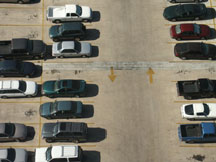Vol. V, No. 2, February / March 2005
Parking lot dynamics
 Parking
lots seem like a rather mundane part of any location-based entertainment
(LBE) facility. The conventional wisdom is that what guests care about
is finding a parking space near the front door. Finding a parking space
within a reasonable walking distance to the front door is important, but
it is only one part of the parking dynamics of how guests, and especially
how moms, will feel about your facility and whether they will want to
return. The design of your parking lot can have a dramatic impact on your
success.
Parking
lots seem like a rather mundane part of any location-based entertainment
(LBE) facility. The conventional wisdom is that what guests care about
is finding a parking space near the front door. Finding a parking space
within a reasonable walking distance to the front door is important, but
it is only one part of the parking dynamics of how guests, and especially
how moms, will feel about your facility and whether they will want to
return. The design of your parking lot can have a dramatic impact on your
success.
Usually, a parking lot's sole function is thought to be a place where guests can store their cars while attending an LBL. A parking lot's purpose goes far beyond the utilitarian function of vehicle storage, at least from the guest's viewpoint. First, the parking lot forms the guests' first and last impressions of an LBL. It is the first and last place they experience and therefore makes a critical contribution to shaping guests' impression and memory of an LBL. If the parking lot leaves a negative impression, it may very well be the guest's strongest and longest lasting memory of the LBL, as it is the last one they experienced.
Secondly, the parking lot is where guests leave the safety of their cars and have to walk through a very public and unmonitored area to get to the LBL. That the parking has open public access to anyone surfaces all sorts of concerns about safety and security, especially for women. Is a mugger hiding somewhere? How about a rapist? Is there someone waiting to abduct their children? According to research by the Independent Insurance Agents of America, 80% of all crimes at shopping centers and malls occur in the parking lot. How safe the parking lot feels (perception is reality to the consumer) is critical in determining whether women will feel the LBL is a safe place to visit. Visibility to and from the front door of the facility to the guest's car and lighting levels are critical elements in shaping that perception of security. So, too, is whether the parking lot has been designed to be what is referred to as a defensible space, one that feels like it is a controlled space.
Developers of properties typically try to make the most of land utilization by maximizing the number of parking spaces within any given area of land. One part of that equation is the sizing of parking spaces, often to the minimum allowed by zoning codes. However, with today's families arriving in vans and SUVs, the typical parking space is usually too narrow, especially for families who have to load and unload children, strollers and all the paraphernalia that comes with the kids. Very tight spaces between vehicles also restricts visibility throughout the parking lot and contributes to feelings of insecurity.
If you think driving in traffic is risky, you haven't tried to walk through a parking lot with young children in tow. You have to be looking out for traffic, watching your children to make sure they don't walk into the path of a moving vehicle, especially ones that may be backing out of a parking space. Pedestrian-friendly parking lots help give guests, and especially moms, a very positive image and memory of your LBL.
Another important consideration for guests is shade. Research has shown that parkers will forgo a close parking space for one much farther away in the shade. In hot climates, well-shaded parking lots add greatly to the appeal of one facility versus the competition.
Along with shade, usually provided by trees, landscaping can contribute to a positive image for your LBL. Well-landscaped parking lots are much more inviting and appealing than a sea of asphalt. Seasonal flowers will greatly enhance a parking area's appeal to women.
Far from a mundane feature of an LBL, well-designed parking areas are
an important part of the equation of creating a guest experience that
generates repeat business.


